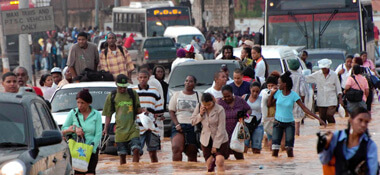KINGSTON, Jun 25 2013 (IPS) – It has taken just eight inches of water for Jamaica to be affected by rising sea levels, with parts of the island nation disappearing completely, threatening people’s livelihoods and much more.
“People speak about the likelihood of Barbuda disappearing in 40 years, but this is a reality in Jamaica at the present time,” Conrad Douglas, a Jamaican scientist who has published more than 350 reports on environmental management and related topics, told IPS.
He pointed to the example of a set of cays called Pedro Cays, of which one “has completely disappeared”.
Pedro Cays are four small, flat (two to five metres high), low-lying and mostly uninhabited cays. The sparse land vegetation consists of six species of plants, none of which are endemic. The cays are regionally important seabird nesting and roosting areas, and they also provide several endangered turtle species, such as hawksbills and loggerheads, with nesting grounds.
More than 400 Jamaicans live for months at a time on the island’s Pedro Cays, which are the primary harvesting area for the largest export of Queen Conch from the Caribbean region.
Douglas said the disappearance of the cays is affecting people’s livelihoods, incomes and lifestyles, “exposing us to all sort of other problems that could threaten the security of the country and of the region”.
Should the phenomenon continue, and “if we don’t adapt”, the entire planet will physically change, he warned.
Scientists have warned that as the seas continue to swell, they will swallow entire island nations from the Maldives to the Marshall Islands, inundate vast areas of countries from Bangladesh to Egypt, and submerge parts of scores of coastal cities.
“We’ve heard the horror stories of some islands in the Pacific already disappearing, so time is certainly not on our hands,” Kenneth Darroux, Dominica’s minister of the environment, told IPS. “The time for action is now.”
Even though Caribbean countries contribute minimally to the causes of climate change that lead to issues such as sea level rise, these countries are the ones who stand to lose the most, Darroux said.
The United Nations has estimated that by the year 2100 the Marshall Islands could be swamped by encroaching waves.
While climate change has the potential to make islands disappear, it also affects people and places globally and can severely damage quality of life.
The World Health Organisation blames 150,000 deaths per year on the effects of climate change, including extreme weather, drought, heat waves, decreased food production and the increased spread of diseases like malaria.
Scientists also warn that if current carbon dioxide emission trends continue, the world’s coral reefs could be virtually destroyed by 2050.
Finding resources
Darroux said one of the biggest challenges faced by small island developing states like Dominica in dealing climate change has to do resources, financial and otherwise.

Credit: Desmond Brown/IPS

























